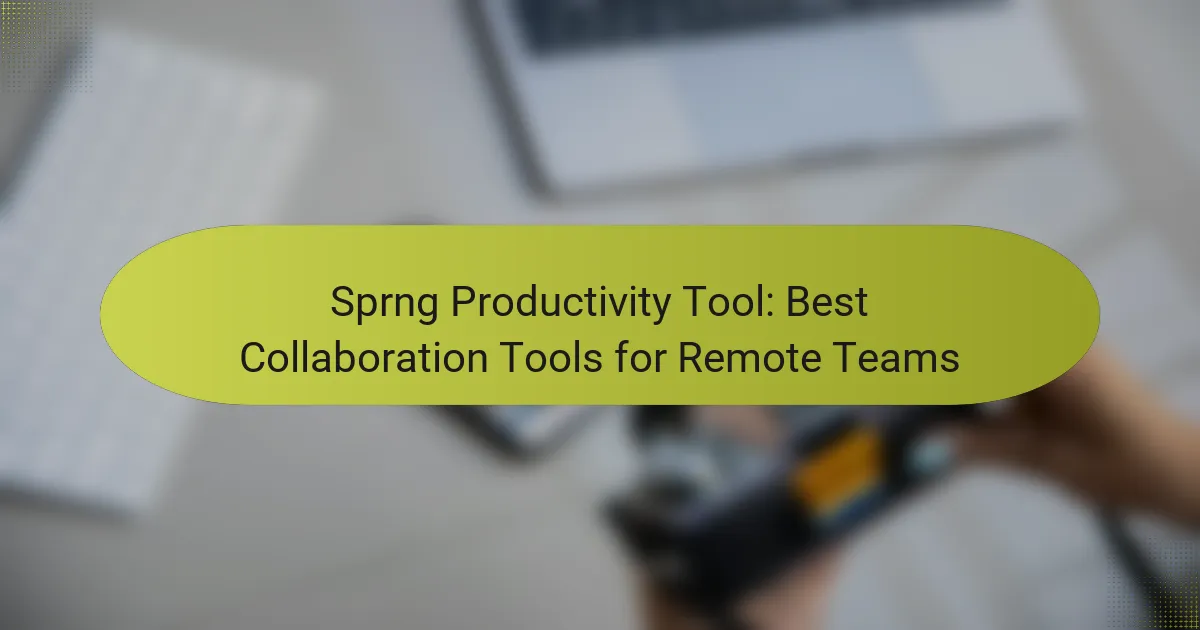In today’s remote work environment, choosing the right collaboration tools is essential for enhancing productivity and ensuring seamless communication among team members. Tools like Slack, Trello, and Microsoft Teams provide effective solutions for project management and real-time interaction, helping teams stay organized and connected regardless of their physical locations. By focusing on user-friendly interfaces and strong integration capabilities, these platforms can significantly streamline workflows and improve overall team efficiency.

What are the best collaboration tools for remote teams in the UK?
The best collaboration tools for remote teams in the UK include platforms that enhance communication, project management, and video conferencing. Popular options like Slack, Trello, Microsoft Teams, Asana, and Zoom cater to various needs, ensuring teams can work effectively from different locations.
Slack
Slack is a messaging platform designed for team communication, allowing users to create channels for different projects or topics. It supports file sharing, integrations with other tools, and direct messaging, making it easy to keep conversations organized.
For UK teams, Slack offers a free tier with limited features, while paid plans provide advanced functionalities like enhanced security and compliance options. Consider using Slack’s integrations to connect with tools like Google Drive or Trello for a seamless workflow.
Trello
Trello is a visual project management tool that uses boards, lists, and cards to organize tasks. It allows teams to track progress, assign tasks, and set deadlines, making it ideal for collaborative projects.
In the UK, Trello’s free version is suitable for small teams, while the Business Class and Enterprise plans offer additional features like automation and advanced integrations. Use Trello’s labels and due dates to prioritize tasks effectively.
Microsoft Teams
Microsoft Teams is a collaboration platform that integrates with Microsoft 365, providing chat, video conferencing, and file sharing capabilities. It is particularly beneficial for organizations already using Microsoft products.
For UK users, Teams offers a free version with limited features, while paid subscriptions provide additional storage and security options. Leverage Teams’ integration with Outlook for streamlined scheduling and communication.
Asana
Asana is a project management tool that helps teams plan, organize, and track work. It offers features like task assignments, timelines, and project overviews, making it easy to manage complex projects.
In the UK, Asana’s free version is adequate for small teams, while premium plans unlock advanced reporting and customization options. Utilize Asana’s templates to kickstart projects and maintain consistency across tasks.
Zoom
Zoom is a video conferencing tool that enables virtual meetings, webinars, and screen sharing. It is widely used for remote team meetings, offering features like breakout rooms and recording options.
For UK teams, Zoom provides a free plan with a 40-minute limit on group meetings, while paid plans offer longer durations and additional features. Ensure you have a stable internet connection to avoid disruptions during meetings.

How do collaboration tools enhance productivity?
Collaboration tools enhance productivity by streamlining communication, organizing tasks, and facilitating file sharing among remote teams. These tools help eliminate misunderstandings and ensure that everyone is on the same page, ultimately leading to more efficient workflows.
Real-time communication
Real-time communication tools, such as chat applications and video conferencing, allow team members to connect instantly regardless of their location. This immediacy helps resolve issues quickly and fosters a sense of teamwork, which is crucial for remote collaboration.
When choosing a communication tool, consider features like message history, video quality, and integration with other platforms. Popular options include Slack, Microsoft Teams, and Zoom, each offering unique functionalities to suit different team needs.
Task management
Task management tools help teams organize and prioritize their work, ensuring that everyone knows their responsibilities and deadlines. These platforms often include features like to-do lists, progress tracking, and deadline reminders, which are essential for maintaining productivity in a remote environment.
When selecting a task management tool, look for user-friendly interfaces and compatibility with other software. Tools like Trello, Asana, and Monday.com are widely used and can adapt to various project management methodologies, such as Agile or Waterfall.
File sharing
File sharing tools enable teams to store, access, and collaborate on documents and files securely. These tools often provide version control and access permissions, which are vital for maintaining data integrity and ensuring that team members can work on the most current documents.
Consider using cloud-based solutions like Google Drive, Dropbox, or OneDrive for easy access and collaboration. Ensure that the chosen platform complies with data protection regulations relevant to your team’s location, such as GDPR in Europe or CCPA in California.

What features should you look for in collaboration tools?
When selecting collaboration tools for remote teams, prioritize user-friendly interfaces, integration capabilities, and robust security measures. These features enhance team productivity and ensure smooth communication across various platforms.
User-friendly interface
A user-friendly interface is essential for collaboration tools, as it ensures that all team members can navigate the software easily without extensive training. Look for intuitive designs that minimize the learning curve and allow quick access to key features.
Consider tools that offer customizable dashboards or layouts, enabling users to tailor their experience according to their preferences. This personalization can significantly improve engagement and efficiency within the team.
Integration capabilities
Integration capabilities are crucial for collaboration tools, as they allow seamless communication between different applications. Look for tools that can connect with popular platforms like Slack, Google Workspace, or Microsoft Teams to streamline workflows.
Evaluate the number of integrations offered and the ease of connecting these tools. A well-integrated system can reduce redundancy and enhance productivity by ensuring that all team members have access to the necessary resources without switching between multiple applications.
Security measures
Security measures are vital when choosing collaboration tools, especially for remote teams handling sensitive information. Look for features such as end-to-end encryption, two-factor authentication, and compliance with industry standards like GDPR or HIPAA.
Regular security audits and updates are also important to protect against vulnerabilities. Ensure that the tool you select has a solid track record of maintaining user data privacy and security, as this builds trust within your team and with clients.

How do pricing models vary for collaboration tools?
Pricing models for collaboration tools can differ significantly based on features, user limits, and support options. Understanding these variations helps teams choose the right tool that fits their budget and needs.
Free plans
Many collaboration tools offer free plans that provide basic features suitable for small teams or individual users. These plans often include essential functionalities like messaging, file sharing, and limited storage but may restrict the number of users or integrations.
For example, tools like Slack and Trello have free versions that allow teams to communicate and manage projects without any cost. However, users should be aware that free plans may lack advanced features such as analytics or customer support.
Subscription tiers
Subscription tiers typically range from basic to premium, offering varying levels of features and support. Basic tiers may include additional storage and integrations, while higher tiers often provide advanced functionalities like enhanced security and priority support.
For instance, a common pricing structure might start around $5 to $15 per user per month for basic plans, scaling up to $25 or more for premium options. Teams should evaluate their specific needs to determine which tier offers the best value.
Enterprise solutions
Enterprise solutions are designed for larger organizations and often include customized pricing based on the number of users and specific requirements. These solutions typically offer advanced security features, compliance with regulations, and dedicated support.
Pricing for enterprise solutions can vary widely, often starting in the low thousands of dollars annually, depending on the scale and complexity of the deployment. Organizations should consider their growth potential and specific collaboration needs when exploring these options.

What are the challenges of using collaboration tools?
Collaboration tools can enhance productivity for remote teams, but they also present challenges that can hinder effectiveness. Common issues include overcommunication, technology overload, and difficulties in maintaining team cohesion.
Overcommunication
Overcommunication occurs when team members share excessive information, leading to confusion and decreased productivity. This often happens in remote settings where individuals may feel the need to over-explain or provide constant updates.
To manage overcommunication, establish clear guidelines on what information needs to be shared and how often. For instance, consider setting specific times for updates rather than constant messaging throughout the day. This helps keep everyone informed without overwhelming them.
Encourage concise communication by using bullet points or summaries in messages. Tools that allow for threaded conversations can also help keep discussions organized, ensuring that team members can focus on relevant topics without sifting through unnecessary details.



